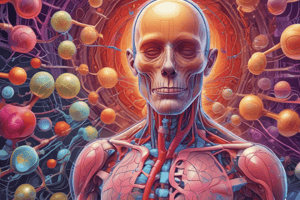Podcast
Questions and Answers
What is the characteristic feature of arteriolar hyalinosis in diabetic nephropathy?
What is the characteristic feature of arteriolar hyalinosis in diabetic nephropathy?
- Intimal fibrosis of arteries
- Loss of smooth muscle cells (correct)
- Accumulation of smooth muscle cells
- Thickness of the media
Which of the following stains is used to highlight interstitial fibrosis?
Which of the following stains is used to highlight interstitial fibrosis?
- Electron Microscopy
- Hematoxylin and Eosin stain
- PAS stain
- Trichrome stain (correct)
What is the effect of arteriolar hyalinosis on the wall of small vessels?
What is the effect of arteriolar hyalinosis on the wall of small vessels?
- Has no effect on the wall thickness
- Makes the wall more expansive (correct)
- Increases the wall thickness
- Decreases the wall thickness
Which part of the nephron is primarily responsible for creatinine secretion?
Which part of the nephron is primarily responsible for creatinine secretion?
What is the effect of hypertension on the media of small vessels?
What is the effect of hypertension on the media of small vessels?
Which of the following is a characteristic feature of diabetic nephropathy?
Which of the following is a characteristic feature of diabetic nephropathy?
What is the primary target of hypertensive kidney injury?
What is the primary target of hypertensive kidney injury?
In diabetic nephropathy, what is the primary adaptive response to glomerular basement membrane thickening?
In diabetic nephropathy, what is the primary adaptive response to glomerular basement membrane thickening?
What is the primary function of the tubulointerstitium in the kidney?
What is the primary function of the tubulointerstitium in the kidney?
What is the stage of chronic kidney disease characterized by a glomerular filtration rate (GFR) of 15-29 mL/min?
What is the stage of chronic kidney disease characterized by a glomerular filtration rate (GFR) of 15-29 mL/min?
What is the primary mechanism of action of erythropoietin in the kidney?
What is the primary mechanism of action of erythropoietin in the kidney?
What is the primary histopathological feature of diabetic nephropathy in the kidney biopsy?
What is the primary histopathological feature of diabetic nephropathy in the kidney biopsy?
What is the typical location where the renal lymphatics drain into?
What is the typical location where the renal lymphatics drain into?
What is the consequence of hyperglycemia in the glomeruli?
What is the consequence of hyperglycemia in the glomeruli?
Which of the following is a common finding in the tubules in Chronic Kidney Disease?
Which of the following is a common finding in the tubules in Chronic Kidney Disease?
What is the effect of Ang II on matrix accumulation in the glomeruli?
What is the effect of Ang II on matrix accumulation in the glomeruli?
What is the consequence of glomerulosclerosis in the glomeruli?
What is the consequence of glomerulosclerosis in the glomeruli?
What is the typical location where the renal arteries enter the kidney?
What is the typical location where the renal arteries enter the kidney?
Which of the following nerves innervates the kidneys?
Which of the following nerves innervates the kidneys?
What is the normal structure of the glomerulus affected by in Chronic Kidney Disease?
What is the normal structure of the glomerulus affected by in Chronic Kidney Disease?
Flashcards are hidden until you start studying
Study Notes
Renal Anatomy
- The perirenal (perinephric) fat and pararenal (paranephric) fat are two types of fat surrounding the kidney.
- The renal fascia is a layer of connective tissue that surrounds the kidney and the perirenal fat.
Blood Supply, Venous Drainage, Lymphatic Drainage, and Nerve Supply
- The kidneys are supplied with blood via the renal arteries, which enter the kidney via the renal hilum.
- The segmental branches of the renal arteries undergo further divisions to supply the renal parenchyma.
- The kidneys are drained of venous blood by the left and right renal veins, which empty directly into the inferior vena cava.
- Renal lymphatics drain directly into the lumbar lymph trunks, which then drain into the thoracic duct, cisterna chyli, and para-aortic nodes.
- The kidneys are innervated by both sympathetic and parasympathetic divisions of the autonomic nervous system (ANS).
Histology
- In chronic kidney disease (CKD), histopathologic changes can be found in four areas: glomeruli, tubules, interstitium, and blood vessels.
- Glomeruli may exhibit glomerulosclerosis, characterized by scarring of the glomeruli.
- Tubules may show tubular atrophy and interstitial fibrosis.
- The interstitium may exhibit increased interstitial fibrosis and inflammation.
- Blood vessels may exhibit arteriosclerosis, characterized by thickening and hardening of the walls of the renal arteries and arterioles.
Histopathologic Changes in CKD
- Glomeruli: glomerulosclerosis, mesangial expansion, and diffuse glomerulosclerosis.
- Tubules: tubular atrophy, interstitial fibrosis, and thickened tubular basement membranes.
- Interstitium: increased interstitial fibrosis and inflammation.
- Blood vessels: arteriosclerosis, arteriolar hyalinosis, and intimal fibrosis.
Creatinine Clearance
- Creatinine is filtered by the glomerulus and secreted by the proximal tubule.
- Creatinine clearance overestimates GFR by 10% to 20%.
Stages of Chronic Kidney Disease
- The National Kidney Foundation has defined five stages of chronic kidney disease (CKD).
Studying That Suits You
Use AI to generate personalized quizzes and flashcards to suit your learning preferences.




